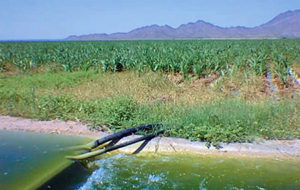
While farming shrimp in the Sonoran Desert of the United States seems like a contradiction, the abundant supplies of moderately saline groundwater have allowed the development of a viable industry there. Numerous marine species have been successfully reared using these inland waters. The isolated location also affords a significant degree of biosecurity.
Inland shrimp farming in Arizona, United States began with niche production of specific-pathogen-free (Litopenaeus vannamei) broodstock. During production of these animals, growth rates up to 1.7 grams per week were realized, which led to the expansion and subsequent commercialization of shrimp farming in the area.
There are currently three commercial producers of L. vannamei in Arizona. In 1999, their production of marine shrimp reached about 90 metric tons (MT), with a farm gate value of over U.S. $1 million.
Effluent studies at Wood Brothers Farm
Arizona offers a unique opportunity to study aquacultural effluents generated from the production of marine species. Ongoing research is under way there to quantify the effluent generated at an inland low-salinity shrimp farm and evaluate the effluent as an irrigation source.
Biweekly sampling was carried out on incoming well water and the effluent generated at the Wood Brothers’ Shrimp Farm in Gila Bend, Arizona. During the 2000 season, the farm had 12 ha of ponds in production (15 production ponds and three nursery ponds). Three samples were collected from each of the two pond types, along with basic environmental information including dissolved oxygen, pH, temperature, and salinity.
The samples were transported on ice to the University of Arizona’s Environmental Research Lab for analysis. Laboratory analysis measured ammonia, nitrate, nitrite, total nitrogen, reactive phosphorus, total phosphorus, alkalinity, chemical oxygen demand, five-day carbonaceous biochemical oxygen demand, total suspended solids and volatile suspended solids.
As shown in Table 1, levels of several parameters increased while the water was in the shrimp pond, while levels of alkalinity and total nitrogen decreased. Total nitrogen losses are attributed to the observed increase in algal and shrimp biomass and volatilization in the ponds.
McIntosh, Levels of selected parameters measured in incoming and effluent water, Table 1
| Parameter | Incoming Water | Effluent Water | Change | Kg/Day |
|---|---|---|---|---|
| TN (mg/l) | 11 | 9 | -2 | -5.45 |
| NH3-N (mg/l) | 0.02 | 0.17 | 0.15 | 0.41 |
| NO2-N (mg/l) | 0.005 | 0.261 | 0.256 | 0.70 |
| NO3-N (mg/l) | 29.3 | 43.3 | 14 | 38.15 |
| TP (mg/l) | 0.4 | 0.74 | 0.34 | 0.93 |
| RP (mg/l) | 0.14 | 0.33 | 0.19 | 0.52 |
| ALK (mg/l) | 134 | 96 | -38 | -103.55 |
| COD (mg/l) | 13 | 23 | 10 | 27.25 |
| CBOD5 (mg/l) | 1.09 | 6.4 | 5.31 | 14.47 |
| TSS (mg/l) | 4.6 | 46.8 | 42.2 | 115.00 |
| VSS (mg/l) | 2.4 | 21.7 | 21.7 | 59.13 |
Effluents carry nutrients, salt
While the increase in nutrients is promising from an irrigation point of view, this information provides only half of the equation for successful secondary use of the water. The remaining half comes from the volumes of water used. Wood Brothers Farm Manager Craig Collins estimated his farm generates 2,725 cubic meters of shrimp farm effluent per day from late May until mid-October.
Combining the two halves of this equation shows that a substantial amount of nutrients from the water becomes available for use as fertilizer (Fig. 1). Despite the potential benefits of a nutrient-rich irrigation source, however, this water is a two-edged sword. In addition to the high levels of nutrients, the water carries salt, which makes soil salinization a valid concern.
During the 2001 growing season, field trials will be conducted to evaluate the effects of these waters on young olive trees. Soil salinity and macronutrients will also be carefully monitored for further study.
Conclusion
By reusing nutrient-rich effluent water for irrigation, aquaculture operations can help reduce or eliminate the need for effluent treatment or disposal, a major issue facing the traditional shrimp aquaculture community. In arid regions where water is a precious commodity, irrigating with aquacultural effluents can also potentially eliminate some of the pressure placed on an already limited resource.
(Editor’s Note: This article was originally published in the December 2001 print edition of the Global Aquaculture Advocate.)
Now that you've finished reading the article ...
… we hope you’ll consider supporting our mission to document the evolution of the global aquaculture industry and share our vast network of contributors’ expansive knowledge every week.
By becoming a Global Seafood Alliance member, you’re ensuring that all of the pre-competitive work we do through member benefits, resources and events can continue. Individual membership costs just $50 a year. GSA individual and corporate members receive complimentary access to a series of GOAL virtual events beginning in April. Join now.
Not a GSA member? Join us.
Author
-
Dennis McIntosh
Graduate Research Associate
University of Arizona
Environmental Research Lab
Tucson, Arizona, USA[109,111,99,46,111,110,117,106,64,49,104,115,111,116,110,105,99,109,100]
Tagged With
Related Posts

Health & Welfare
Evaluating a commercial functional diet in AHPND-infected juvenile Pacific white shrimp
A series of experiments – including in vitro, in vivo and also field trials – investigated if a functional diet could reduce AHPND in Pacific white shrimp.

Health & Welfare
Big shoes to fill: Dhar takes reins at shrimp pathology laboratory
Arun Dhar, Ph.D. will attempt to fill the “big shoes” of Dr. Donald Lightner at the University of Arizona’s Aquaculture Pathology Laboratory, where the shrimp disease EMS was diagnosed.

Health & Welfare
EHP a risk factor for other shrimp diseases
Laboratory challenges and a case-control study were used to determine the effects of EHP infection on two Vibrio diseases: acute hepatopancreatic necrosis disease (AHPND) and septic hepatopancreatic necrosis (SHPN).

Health & Welfare
Hybrid assay can detect IMNV in resource-poor settings
The method can shorten analysis time and has applications for IMNV diagnosis in resource-poor settings because it does not require specialized equipment.


